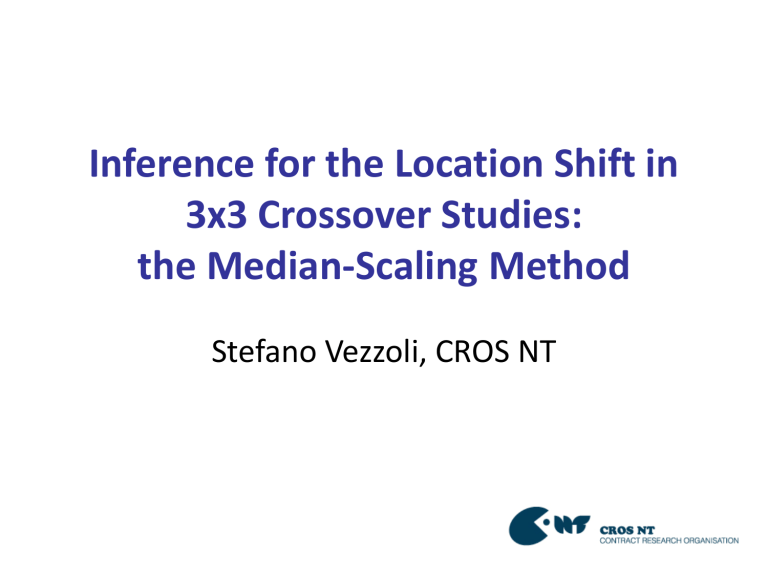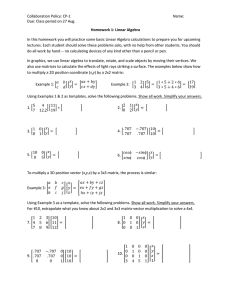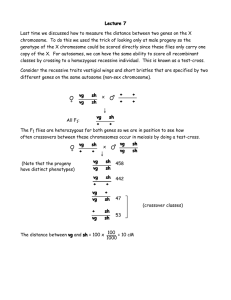Inference for the Location Shift in 3x3 Crossover Studies: the Median-Scaling Method

Inference for the Location Shift in
3x3 Crossover Studies: the Median-Scaling Method
Stefano Vezzoli, CROS NT
Agenda
•
Purpose of the median-scaling (MS) method
•
2-treatment, 2-period, 2-sequence crossover design
•
3-treatment, 3-period, 6-sequence crossover design
•
The %MSCI macro
•
Limitations of the MS method
•
Questions
Purpose of the MS method
• To obtain the point estimate and the confidence interval (exact or asymptotic) for the location shift between treatments (no p-values)
• Applicable with 3x3 crossover designs where all six possible treatment sequences are used
• The effect of period is taken into account
• Nonparametric method useful when the assumptions of the standard approaches based on parametric inference are not valid (e.g., severe departures from normality)
• Originally introduced for the analysis of t max
(Pharmaceut Statist 2008) by Willavize and Morgenthien
Location shift
• The location shift estimated using the MS method can be interpreted as the difference between treatment medians (or means) if the shift model holds:
G(x) = F(x+Δ)
Location shift
• Or if the underlying distributions are symmetric with heterogenous variances
• In this case the exact confidence interval should be used instead of the asymptotic one (Rosenkranz, Pharmaceut Statist 2009)
Location shift
• Rosenkranz also observes that
“when the variables to be compared arise from differences like changes from baseline, there is a good chance for an (almost)
symmetrical distribution”.
2x2, 2-sequence crossover design
• The MS method can be viewed as an extension of an approach for a 2x2,
2-sequence crossover design
• Let assume that an adequate model for the data is x ijk
= µ + γ i
+ s ij
+ π k
+ φ l
+ e ijk
– µ : general mean
– γ i
: fixed effect of the i-th sequence
– s ij
: random effect of the j-th subject within the i-th sequence
– π k
: fixed effect of the k-th period
– φ l
: fixed effect of the l-th treatment (l = R, T)
– e ijk
: random within-subject error
– no carry-over
2x2, 2-sequence crossover design
• Let x ij denote the difference between periods 1 and 2 in the i-th sequence: for the j-th subject x ij
= x ij1
– x ij2 period
1 2
1 T R
2 R T
Sequence 1: x
1j
= (π
1
– π
2
)
+ Δ
+ (e
1j1
– e
1j2
)
Sequence 2: x
2j
= (π
1
– π
2
)
- Δ
+ (e
2j1
– e
2j2
)
Δ = φ
T
-
φ
R
: unknown shift in location due to the test treatment
2x2, 2-sequence crossover design
• Thus, when comparing the period differences of two subjects included in different sequence groups (TR vs. RT), we obtain x
1j
– x
2j
=
= (π
1
– π
2
)
+ Δ
+ (e
1j1
– e
1j2
) – [(π
1
– π
2
)
- Δ
+ (e
2j1
– e
2j2
)] =
=
2Δ
+ error
2x2, 2-sequence crossover design
• Based on this result, the following approach is adopted
– the two sequence groups are considered as independent random samples
– parellel-group methods are applied to the within-subject period differences
– the Hodges-Lehmann point estimate and confidence limits are calculated for 2Δ
– the values obtained are divided by 2
2x2, 2-sequence crossover design
• The inferential procedures used are associated with the Wilcoxon rank sum test , as the confidence interval for Δ is obtained through inversion of this specific test
• If the period effect is considered negligible, similar procedures based on the Wilcoxon signed rank test may be preferred.
3x3, 6-sequence crossover design
• The same model defined for the 2x2 design is assumed to hold
• The starting point is the sequence stratification : in order to compare two treatments (say A and B), the sequences are arranged in pairs, grouping together the sequences where A and B occur in the same periods period
1 2 3
1 A B C
2 B A C
3 A C B
4 B C A
5 C A B
6 C B A
Stratum 1: treatments administered in periods 1 and 2
Stratum 2: treatments administered in periods 1 and 3
Stratum 3: treatments administered in periods 2 and 3
3x3, 6-sequence crossover design period
1 2 3
1 A B C
2 B A C
3 A C B
4 B C A
5 C A B
6 C B A
Stratum 1 period differences
ABC: x
1j
= (π
1
– π
2
) + Δ + (e
1j1
– e
1j2
)
BAC: x
2j
= (π
1
– π
2
) - Δ + (e
2j1
– e
2j2
)
Stratum 2
ACB: x
3j
= (π
1
– π
3
) + Δ + (e
3j1
– e
3j3
)
BCA: x
4j
= (π
1
– π
3
) - Δ + (e
4j1
– e
4j3
)
Stratum 3
CAB: x
5j
= (π
2
– π
3
) + Δ + (e
5j2
– e
5j3
)
CBA: x
6j
= (π
2
– π
3
) - Δ + (e
6j2
– e
6j3
)
• The estimates of the treatment difference independently provided by the strata cannot be easily combined since they include different period effects
3x3, 6-sequence crossover design
• This problem is solved by introducing the concept of median-scaling
• Data from different experiments could be made comparable by subtracting some estimate of the location of each experiment from all observations of the experiment
• In our case :
– experiment = stratum
– the stratum median is subtracted from all observations within the stratum
– Then, the median-scaled period differences from all the strata can be ranked together
3x3, 6-sequence crossover design
• An estimate of the location of each experiment…
– m p
= median period difference in stratum p (p= 1, 2, 3)
• …is subtracted form all observations of the experiment: period
1 2 3
1 A B C
2 B A C
3 A C B
4 B C A
5 C A B
6 C B A median-scaled period differences
Stratum 1
ABC: z
1j
= x
1j
– m
1
BAC: z
2j
= x
2j
– m
1
Stratum 2
ACB: z
3j
= x
3j
– m
2
BCA: z
4j
= x
4j
– m
2
Stratum 3
CAB: z
5j
= x
5j
– m
3
CBA: z
6j
= x
6j
– m
3
3x3, 6-sequence crossover design
• Now we are allowed to apply the same approach as in the 2x2 design
A
B
B
A
A B C
B A C
A C B
B C A
C A B
C B A z z ij ij
= …
+ Δ
+ … (i = 1, 3, 5)
= …
- Δ
+ … (i = 2, 4, 6)
• The roles of x
1j respectively.
(A before B in the sequence) and x
2j
(B before A in the sequence) in the 2x2 design are now played by z
1j
, z
3j
, z
5j and z
2j
, z
4j
, z
6j
,
3x3, 6-sequence crossover design
• What has changed from the method used with 2x2 design?
– z
1j
, z
3j
, z
5j samples and z
2j
, z
4j
, z
6j are considered as independent random
– parellel-group methods are applied to the median-scaled withinsubject period differences
– the Hodges-Lehmann point estimate and confidence limits are calculated for 2Δ
– the values obtained are divided by 2
3x3, 6-sequence crossover design
• The MS method allows for
– tied observations
– unequal allocation of subjects to sequences
– missing data (if for a subject the response is missing for at least one treatment involved in the comparison of interest, that subject is not taken into account in the analysis)
• If the period effect is ignored, an approach based on the Wilcoxon signed rank test may be applied by considering the data for any two treatments being compared as if they were the only treatments which have been studied
3x3, 6-sequence crossover design
• Example
– We are interested in the comparison A vs. C
– Note that the comparison between A and C requires a different grouping of sequences the the one used to compare A and B z
1j z
2j
Stratum 1: treatments administered in periods 1 and 2
Period 1 – Period 2
The %MSCI macro
%MSCI(ds=,t1=,t2=,alpha=,exact=);
• ds : dataset to be analysed
– each observation must correspond to a subject
– 4 variables required: sequence (“ABC”, ACB”, etc.) and p1, p2, p3 (responses observed in the three treatment periods)
• t1 and t2 : treatments to be compared (t1=A, t2=B: A-B will be evaluated)
• alpha : confidence level of the interval
• exact : if =1, also the exact confidence limits will be generated
The %MSCI macro
%MSCI(ds=dataset,t1=A,t2=C,alpha=.05,exact=1);
• By specifying exact=1, we are also requiring the exact confidence limits.
• After submitting the above code, we obtain the following output :
Limitations
• The properties of the MS method in terms of coverage, confidence interval length and bias have been evaluated by Willavize and
Morgenthien based on a simulation study
• Good performances have been demonstrated by simulating typical data for t max
• Further investigation would be required to confirm the wider applicability of the MS method
Any questions?


